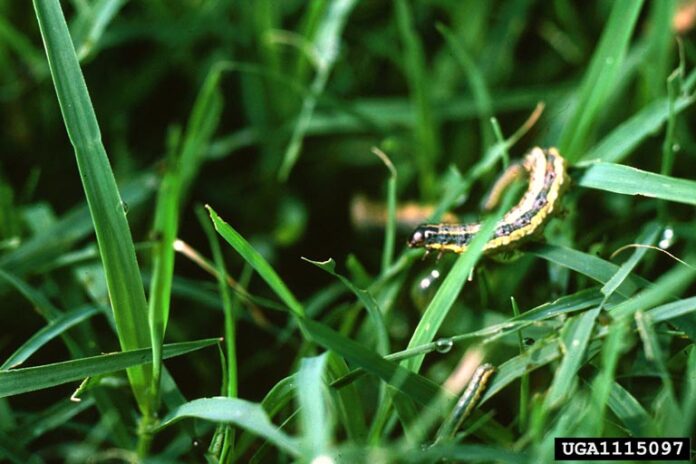AUBURN UNIVERSITY, Ala. – They say there are only a few things that are certain in life. Most forage producers in the Southeast would argue fall armyworm invasions are one of them. Yes, once again, fall armyworms are making their way onto the scene in multiple parts of Alabama.
Katelyn Kesheimer, an Alabama Extension entomologist, said the hot, dry weather conditions the state is experiencing have paved the way for a fall armyworm outbreak.
“Growers have already found treatable numbers of armyworms in many bermudagrass fields,” Kesheimer said. “If not already doing so, producers should start scouting their fields and be prepared to treat.”
Start scouting now
Fall armyworms can cause untold damage to pastures and hay fields if growers do not take proper scouting measures. Kesheimer said it is important to catch populations while they are small.
“Young caterpillars do not eat much and therefore are not going to cause substantial damage,” she said. “However, if left undetected, they can continue to feed and reduce yield.”
If regular scouting is not in place, it may seem like armyworms appear overnight. It’s hard to spot fall armyworm damage until it is already too late. This is why scouting for worms instead of damage is so important.
“By the time a producer sees obvious feeding damage or big worms, they have likely already lost some yield and control will be difficult,” Kesheimer said. “That’s why getting out there early with a sweep net to scout is the best defense we have against this consistent pest.”
Proper scouting methods
A sweep net is the easiest and most efficient way to scout a field. Kesheimer said it is a good practice for producers to keep a sweep net in their vehicles. If a producer does not own a sweep net, most Alabama Extension county offices have one that they can borrow.
Fall armyworms do not like to be out in the heat of the day. Because of this, scouting early in the morning or later in the evening will offer the best results.
“During the heat of the day, worms will crawl down into the thatch layer to stay cool and will be more difficult to spot,” Kesheimer said. “If you scout when it’s still cool, you’ll likely catch the armyworms on the grass blades feeding and your counts will be more accurate.”
Control early
It is better to be proactive against armyworms and seek control early while the worms are small. Kesheimer said larger worms cause the most damage and are the most difficult to kill with insecticides.
“If producers find worms in a field that is close to being ready to harvest, the best action is to go ahead and harvest it,” she said. “If the worms are found in a field that is used for grazing, use the cattle to intensively graze before they eat everything.”
When scouting, if a producer finds several worms, they should select a few other areas of the field to examine. In these areas, they should mark off approximately 1 square foot and scout for worms. Kesheimer said if there are two to three caterpillars per square foot, she recommends chemical control.
Chemical options
There are several available products that provide control of fall armyworms. Kesheimer said it is important to note the pre-harvest interval of any product that a grower chooses to use.
“These may vary depending on if the grass will be cut and bailed for hay or if it will be grazed,” she said.
Cost per acre also plays an important role in deciding what chemical to use. While pyrethroids, such as Karate and Baythroid, are an effective and cheap option, they do not have as long of a residual as the insect growth regulators. Insect growth regulators, like Intreprid and Dimilin, are slower-acting and most effective when the caterpillars are small, but provide a longer residual. Growers should also note that pyrethroids are restricted-use products. They will need a valid pesticide applicator license to purchase and apply them.
Kesheimer said in some cases, growers may want to tank mix two products, one pyrethroid and one insect growth regulator.
“In a year like this where there is heavy pressure early in the cutting cycle, the pyrethroid will provide a quick knockdown of the worms, while the insect growth regulator will provide residual control,” Kesheimer said. “If you are more than one week away from the next cutting, using something with a longer residual is likely worth the additional cost per acre.”
Insecticide options for controlling armyworms are available in the Alabama Extension Pastures and Forage Crop IPM Guide.
More information
More information on fall armyworms is in the Alabama Extension publication “Management of Fall Armyworm in Pastures and Hayfields.” For further information, visit www.aces.edu or contact the animal sciences and forages agent assigned to your area.
Trade and brand names used are given for information purposes only. No guarantee, endorsement, or discrimination among comparable products is intended or implied by the Alabama Cooperative Extension System.




















